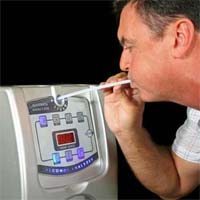Breath Test May Finally Offer a Way to Screen for Pleural Mesothelioma
 Earlier diagnosis of malignant pleural mesothelioma may be just a breath away.
Earlier diagnosis of malignant pleural mesothelioma may be just a breath away.
A new Belgian study shows that two kinds of breath-analyzing tests may finally offer an accurate way to screen for the deadly asbestos cancer. An accurate screening tool could lead to earlier mesothelioma diagnosis, earlier intervention, and, potentially, better treatment outcomes.
Pleural mesothelioma is an extremely rare but aggressive cancer caused almost exclusively by exposure to asbestos fibers. Most people encounter these fibers in a work environment and most have no idea they are sick until mesothelioma is in an advanced stage and the odds of survival are slim.
Although there are diagnostic tools that identify biomarkers in the blood or lung fluid of people with mesothelioma symptoms, there is currently no screening test.
Breath Testing for Earlier Mesothelioma Detection
In a multi-center study conducted by several Belgian universities and the University of Amsterdam, researchers demonstrated that gas chromatography-mass spectrometry (GC-MS) and eNose technologies – both of which fall under the category of breathomics – are capable of picking out mesothelioma patients with a high degree of accuracy.
The researchers took breath samples from 64 subjects: 16 healthy people, 19 people who had been exposed to asbestos but were not sick, 14 patients with malignant pleural mesothelioma, and 15 people with other asbestos-related diseases.
Their breath samples were analyzed with both GC-MS and eNose, which evaluate exhaled breath for the presence of certain volatile organic compounds (VOCs). VOCs can give doctors important information about the metabolism of cells and can indicate the presence of disease.
Can Breath Analysis Identify Malignant Mesothelioma?
The researchers found that the two technologies – especially when used together – were highly effective at not only identifying the possible presence of mesothelioma, but also of distinguishing mesothelioma patients from people with other illnesses or those who had simply been exposed to asbestos.
“Using GC-MS, asbestos-exposed individuals were discriminated from malignant pleural mesothelioma patients with 97% accuracy, with diethyl ether, limonene, nonanal, methylcyclopentane and cyclohexane as important VOCs,” study author Kevin Lamote of Ghent University writes in the journal Oncotarget. “This was validated by eNose analysis.”
In addition, GC-MS was 94% accurate at discriminating both asbestos-exposed people and people with other asbestos-related diseases from those who had been diagnosed with pleural mesothelioma. The eNose could do so with 74% accuracy.
GC-MS accurately identified pleural mesothelioma 100% of the time and was able to rule out people who did not have pleural mesothelioma in 91% of cases. eNose was slightly less accurate with a sensitivity of 82% and a specificity of 55%.
Breathomics for Mesothelioma Screening: Good But Not Perfect
The researchers conclude, “This study shows accurate discrimination of patients with MPM from asymptomatic asbestos-exposed persons at risk by GC-MS and eNose analysis of exhaled VOCs and provides proof-of-principle of breath analysis for MPM screening.”
Breath analysis is simple, non-invasive, fast, and inexpensive, but it may not be perfect. Previous research suggests that it may be more difficult to tell one type of cancer from another with breathomics. Research to help distinguish VOCs from one type of cancer from VOCs produced by people with another type is ongoing.
Source:
Lamote, K, et al, “Breath analysis by gas chromatography-mass spectrometry and electronic nose to screen for pleural mesothelioma: a cross-sectional case-control study”, September 27, 2017, Oncotarget, pp. 91593-91602





